
No, no, Nosema

I’m giving you fair warning. If you’re the kind of person who gets queasy easily, better skip this blog. I’m going to talk about icky stuff.
Here it is: I never thought that my job at Sunset would include analyzing bee poo with my co-worker, Kimberley Burch. But it does.
Hey, it’s not that gross. After all, bees only eat honey and pollen. And it’s the kind of thing you have to pay attention to if you’re going to manage livestock. Our One-block diet has turned us into urban farmers here at Sunset.
Here’s what happened. We checked the girls during some rainy weather earlier this week. There were still bees flying, even in the rain, but not many. Then, on Wednesday, after the rains had stopped, we noticed several spatters of yellow bee poo on the cement pad and one spatter on Hive Betty.
What now?! Bees are terrifically clean house keepers. If at all possible, they won’t soil their hive, or the surrounding area. In winter while they are trapped inside the hive by inclement weather, they “hold it” until better weather and they are able to make a cleansing flight and get far away from the homestead (or hivestead).
We’re worried by these spatters so close to the hives. It could be bee dysentery. It could be signs of a bee virus called Nosema apis, which is a little like bee flu. Some think this nasty virus, and its close relation, Nosema ceranae, could be one of the causes of colony collapse disorder. (For another theory about the cause of colony collapse, see Sharon Cohoon’s blog on nicotine-based pesticides in our Fresh Dirt blog.)
Today is warm and sunny and the girls are out in force. I see no new tell-tale yellow spots. Perhaps what we saw was simply a the results from a few bees who couldn’t get away fast enough.
We’re trying not to worry, but it’s awfully hard not to get emotional about bees.
Yet another worrisome sign. Bees on the ground, unable to fly. Could be Nosema. Could be a sign of tracheal mites. Or could just be cold bees.

